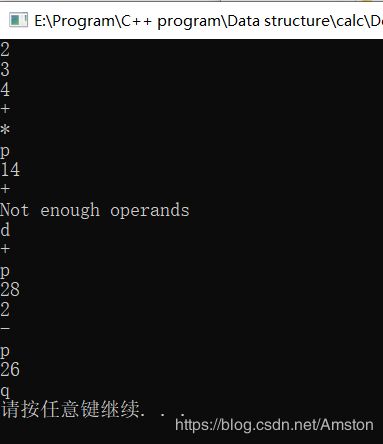- C/C++后端开发八股文
CielBleu_CN
c语言c++开发语言
一.C/C++编程1.Main函数之前执行(作为main,完成存储内容的构造)设置栈指针初始化静态变量(static)和全局变量(global)赋值全局变量(可能在完成以上过程中执行的内容)调用构造函数(main作为函数)将main函数的参数argc,argv等传递给main函数【C的存储构造如下图】2.Main函数之后执行(作为main结束)atexit注册的函数(传递信息,处理等)->倒序执行
- Python实现链表反转:迭代与递归双解法详解
达不溜先生 ୧⍢⃝୨
python数据结构链表算法leetcode
目录一、问题描述二、核心代码实现2.1迭代法实现迭代法中的prev初始值是None的原因:关键步骤图解2.2递归法实现递归法中要设置head.next=None的原因递归过程拆解三、方法对比与选择建议一、问题描述链表反转是数据结构中的基础算法问题,常见于面试和算法题库(如LeetCode#206)。要求将单向链表的节点顺序完全倒置二、核心代码实现2.1迭代法实现时间复杂度:O(n)空间复杂度:O(
- 第 146 题「LRU缓存机制」(手撸LRU算法)
冰火同学
力扣缓存数据结构算法
首选用比较通俗的语言来讲一讲LRU算法,那手机内存来举例子,就是当内存超出了手机设置的内存后,就要删除了内存,那删除那部分内存呢,LRU算法就是提供一个策略来选择那些需要缓存需要被删除掉,就是谁隔得最远就删除掉谁。LRU算法的描述怎么描述呢,其实上述描述的就是LRU算法要实现的逻辑只不多是人能理解的活,那么如何从写代码的角度来说一下实现LRU算法的逻辑呢,这个时候就要通过基础的数据结构结合来讲LR
- 总结一下c++的STL容器各个容器的特点和常用方法
已是上好佳
c++开发语言
序列容器1.std::vector特点:动态数组,支持随机访问,可通过下标直接访问元素,访问效率高(时间复杂度为\(O(1)\))。内存是连续分配的,在尾部插入和删除元素的效率较高(平均时间复杂度为\(O(1)\)),但在中间或头部插入和删除元素时,需要移动大量元素,效率较低(时间复杂度为\(O(n)\))。会自动管理内存,当容量不足时会自动重新分配更大的内存空间,并将原有元素复制过去。常用方法:
- 全网精简版js数据结构——排序
..儒
数据结构jsjavascript数据结构前端
冒泡排序functionBubbleSort(){const{length}=arrayfor(leti=0;iarr[j+1]){swap(arr,j,j+1)}}}console.log(arry);}functionswap(arry,a,b){consttemp=arry[a]arry[a]=arry[b]arry[b]=temp//或者用[arry[b],arry[a]]=[arry[a
- 《 C++ 点滴漫谈: 三十 》高手写 C++,参数这样传才高效!你真的用对了吗?
Lenyiin
编程显微镜c++函数参数值传递引用传递指针传递可变参数完美转发
摘要C++函数参数的传递方式直接影响代码的性能与可读性。在本篇博客中,我们全面探讨了C++的各种参数传递方式,包括值传递、引用传递、指针传递等,并深入解析了**constexpr、consteval、std::forward、完美转发、auto模板推导等现代C++特性。此外,我们总结了不同场景下的最佳实践**,帮助开发者在实际编程中做出最优选择,提升代码质量与执行效率。无论是初学者还是有经验的C+
- 第十章:C++ 标准
weisonx
C++全栈知识体系c++
第十章:C++标准C++语言不断演进,每个新版本都引入了新的特性和改进。本章将详细介绍C++11、C++14、C++17、C++20和C++23的重要特性及其对C++开发的影响。通过对这些标准的学习,读者可以掌握现代C++编程的最新趋势,提高代码的可维护性、性能和可扩展性。10.1C++11:现代C++的开端C++11标准是C++语言历史上的一次重大更新,它引入了大量的新特性,使得C++语言更加现
- 常用图像增强算法原理及 OpenCV C++ 实现
埃菲尔铁塔_CV算法
opencv计算机视觉人工智能c++算法机器学习
一、引言图像增强是数字图像处理中的一个重要分支,其目的是改善图像的视觉效果,突出图像中的重要信息,或者将图像转换为更适合人或机器分析处理的形式。在实际应用中,图像增强技术广泛应用于医学影像、遥感图像、安防监控等领域。本文将详细介绍常用的图像增强算法原理,并给出基于OpenCVC++库的实现代码。二、图像增强算法分类图像增强算法可以分为空间域增强和频域增强两大类。空间域增强是直接对图像的像素值进行操
- 算法与数据结构(回文数)
a_j58
数据结构
题目思路对于这个我的第一想法就是转换为字符串然后判断字符串是否为回文,它会消耗额外的地址空间。还有一种想法就是将数字反转并判断是否为回文,但可能需要处理数字溢出的问题。若要避免出现数字溢出的问题,我们可以只反转它的一半,若前半部分和后半部分相同,则说明它是一个回文数。如123321,我们将它的后半部分反转,得到123,它与前半部分相同,说明它是一个回文数。算法首先,我们可以先考虑到它的一些临界情况
- ZooKeeper学习总结(1)——ZooKeeper入门介绍
一杯甜酒
ZooKeeper学习总结Zookeeper
1.概述Zookeeper是Hadoop的一个子项目,它是分布式系统中的协调系统,可提供的服务主要有:配置服务、名字服务、分布式同步、组服务等。它有如下的一些特点:简单Zookeeper的核心是一个精简的文件系统,它支持一些简单的操作和一些抽象操作,例如,排序和通知。丰富Zookeeper的原语操作是很丰富的,可实现一些协调数据结构和协议。例如,分布式队列、分布式锁和一组同级别节点中的“领导者选举
- 【OpenCV C++】存图,如何以时间命名,“年月日-时分秒“产生唯一的文件名呢?“年月日-时分秒-毫秒“ 自动检查存储目录,若不存在自动创建存图
R-G-B
OpenCVC++C/C++opencvc++人工智能
文章目录1生成文件名(格式:"年月日-时分秒"格式)2生成文件名(格式:"年月日-时分秒-毫秒")3多模式存图函数4综合调用实例5注意:默认参数只能在头文件中定义,不能在实现中重复默认参数mode==1→“年月日-时分”→YYYYMMDD-HHMM的文件名;例如:20250310-1647mode==2→"年月日-时分秒-毫秒"→YYYYMMDD-HHMMSS-MMM(适用采集存储帧率搞得图片,增
- C++:const和constexpr两个关键字
壹十壹
C++c++
在C++中,constexpr和const是两个关键字,用于定义常量,但它们有不同的语义和用途。以下是它们的详细对比和示例:1.const含义:表示变量是只读的,其值在程序运行期间不能被修改。初始化:可以在运行时(run-time)进行初始化。用法:通常用于修饰变量、函数参数或返回值。不能保证变量在编译期求值。示例constintx=10;//编译时常量inty=20;constintz=y;//
- qt c++线程中的同步和异步
我要进步!
qtc++
一、线程同步用于协调多个线程对共享资源的访问,避免竞态条件。常用工具:QMutex(互斥锁)保护临界区,确保一次仅一个线程访问资源。QMutexmutex;intsharedData=0;voidThread::run(){mutex.lock();sharedData++;//安全操作mutex.unlock();}QMutexLocker自动管理锁生命周期:{QMutexLockerlocke
- ES6解构赋值详解
漫天转悠
ES6es6前端ecmascript
ES6解构赋值详解ES6解构赋值是JavaScript语言的一项强大特性,它允许从数组或对象中提取数据,并将其赋值给变量。这一特性不仅简化了代码,提高了可读性,还增强了代码的灵活性。本文将详细介绍ES6解构赋值的基本概念、语法、应用场景以及一些高级用法。1.基本概念解构赋值是对赋值运算符的扩展。它允许按照一定的模式,从数组或对象中提取值,并赋值给变量。这种语法使得从复杂数据结构中提取数据变得更加简
- C 语言中的数组详解
812503533
c语言java开发语言
在C语言中,数组是一种非常基础且常用的数据结构。数组是存储一组相同类型元素的集合,允许我们以统一的方式访问和操作这些元素。C语言中的数组不仅在编程中使用广泛,而且它的灵活性和效率使得它成为了许多算法实现的基础。本篇文章将深入分析C语言中的一维数组,包括定义、存储方式、操作方式、常见问题等等,所有的数据结构都可以从这几个方面来学习。1.数组的定义与存储方式1.1一维数组的定义数组的定义方式包括数组大
- 【春招笔试真题】饿了么2025.03.07-开发岗真题
春秋招笔试突围
最新互联网春秋招试题合集java算法网络
饿了么2025.03.07-开发岗题目1️⃣:统计01串中0和1的个数,通过计算可能的交换方式确定不同字符串数量2️⃣:使用模板匹配技术识别验证码图片中的"#"符号分布模式3️⃣:构建字典树(Trie)优化异或查询,实现高效的数字黑板游戏整体难度这套题目整体难度适中,由简到难逐步递进:第一题是基础的计数问题,需要理解交换操作的特性第二题是模式识别问题,需要实现模板匹配第三题是高级数据结构应用,需要
- C++ time(0)函数
宁玉AC
c学习
time(0)函数返回当前格林尼治标准时间与格林尼治标准时间1970年0分0秒的时间间隔。头文件#include//问题:得到当前时间。#include#includeusingnamespacestd;intmain(){inttotalSeconds=time(0);intcurrentSeconds=totalSeconds%60;inttotalMinutes=totalSeconds/6
- C++随机数
宁玉AC
c学习c++开发语言
目录一、名著参考二、详解1.rand()函数2.time(0)3.srand(time(0))4.获取指定范围内的随机数(含指定位数)一、名著参考可以使用cstdlib头文件中的rand()函数来获得随机整数;这个函数返回0~RAND_MAX之间的随机整数;rand()函数生成的是伪随机数。即每次在同一个系统上执行这个函数的时候,rand()函数生成同一序列的数。rand()函数的算法使用一个叫种
- C++11之列表初始化
Octopus2077
c++学习笔记
发展历史C++11是C++的第⼆个主要版本,并且是从C++98起的最重要更新。它引⼊了⼤量更改,标准化了既有实践,并改进了对C++程序员可⽤的抽象。在它最终由ISO在2011年8⽉12⽇采纳前,⼈们曾使⽤名称“C++0x”,因为它曾被期待在2010年之前发布。C++03与C++11期间花了8年时间,故⽽这是迄今为⽌最⻓的版本间隔。从那时起,C++有规律地每3年更新⼀次。列表初始化(注意区分列表初始
- 刷题前必学!二叉树!用JavaScript学数据结构与算法
JavaScript算法与数据结构-HowieCong务必要熟悉JavaScript使用再来学!一、树是什么?数据结构中的树,对于现实世界中的树简化——树根抽象为“根节点”,树枝抽象为“边”,树枝的两个端点抽象为“结点”,树叶抽象为“叶子结点”计算机中的树如下:二、树的重点树的层次计算规则:根结点所在的那一层为第一层,其子节点为第二层,以此类推结点和树的高度计算规则:叶子结点高度为1,每向上一层
- HarmonyOS Next 实现 2048 小游戏
2048是一款经典的益智游戏,玩家通过滑动屏幕合并相同数字的方块,最终目标是合成数字2048。本文基于鸿蒙ArkUI框架,详细解析其实现过程,解析如何利用声明式UI和状态管理构建此类游戏。一、核心数据结构与状态管理1.游戏网格与得分游戏的核心是一个4x4的二维数组,用于存储每个格子的数字。通过@State装饰器管理网格状态,确保数据变化时UI自动刷新:@Stategrid:number[][]=A
- 基于llama_cpp 调用本地模型(llama)实现基本推理
月光技术杂谈
大模型初探llamallama.cpppythonLLM集成显卡本地模型AI
零基础实践本地推理模型基本应用:基于llama_cpp的本地模型调用。本文先安装llama_cpppython库,再编写程序,利用其调用llama-2-7b-chat.Q4_K_M.ggu模型。背景llama_cpp是一个基于C++的高性能库(llama.cpp)的Python绑定,支持在CPU或GPU上高效运行LLaMA及其衍生模型(如LLaMA2),并通过量化技术(如GGUF格式)优化内存使用
- 动态规划双剑合璧:C++与Python征服洛谷三大经典DP问题
三流搬砖艺术家
动态规划c++python
动态规划核心思想状态定义→转移方程→边界处理→时空优化本文精选洛谷动态规划题单中三大经典问题,通过C++与Python双语言对比实现,彻底掌握DP精髓!题目一:P1048采药(01背包模板)题目描述在限定时间T内采集草药,每株草药有采集时间time[i]和价值value[i],求最大总价值。解题思路状态定义:dp[j]表示时间j能获得的最大价值转移方程:dp[j]=max(dp[j],dp[j-t
- C语言_数据结构总结7:顺序队列(循环队列)
*.✧屠苏隐遥(ノ◕ヮ◕)ノ*.✧
C语言—数据结构数据结构c语言开发语言算法visualstudiovisualstudio
纯C语言实现,不涉及C++队列简称队,也是一种操作受限的线性表。只允许表的一端进行插入,表的另一端进行删除特性:先进先出针对顺序队列存在的“假溢出”问题,引出的循环队列概念。循环队列将顺序队列臆造为一个环状的空间,即把存储队列元素的表从逻辑上视为一个环。当队首指针Q->front=MaxSize-1后,再前进一个位置就自动到0,这可以利用除法取余运算(%)来实现。循环队列中的判空和判满条件分析:显
- C++:入门详解(关于C与C++基本差别)
梅茜Mercy
c++c语言java
目录一.C++的第一个程序二.命名空间(namespace)1.命名空间的定义与使用:(1)命名空间里可以定义变量,函数,结构体等多种类型(2)命名空间调用(::)与展开(3)命名空间的嵌套(4)具体使用场景三.缺省参数1.基本定义:2.几个注意:四.函数重载1.定义与使用:五.引用1.定义:2.引用的特性:3.引用的使用(区别传值返回和传引用返回):4.const引用:六.inline内联一.C
- C++开源库大全
大王算法
C/C++开发实战365C++入门及项目实战宝典c++开源
程序员要站在巨人的肩膀上,C++拥有丰富的开源库,这里包括:标准库、Web应用框架、人工智能、数据库、图片处理、机器学习、日志、代码分析等。标准库C++StandardLibrary:是一系列类和函数的集合,使用核心语言编写,也是C++ISO自身标准的一部分。
- 【数据结构】-- LinkedList与链表(2)
雨雨雨雨点子
数据结构数据结构链表java开发语言
文章目录4.LinkedList的模拟实现5.LinkedList的使用5.1什么是LinkedList5.2LinkedList的使用5.2.1LinkedList的构造5.2.2LinkedList的其他常用方法介绍5.2.3LinkedList的遍历6.ArrayList和LinkedList的区别4.LinkedList的模拟实现publicclassMyLinkedList{static
- C++11使用mutex和condition_variable实现线程同步
追烽少年x
C++基础c++
C++11使用mutex和condition_variable实现线程同步在实现项目的过程中,突然有一个问题:C++中A、B、C三个线程模拟购买100张车票,A输出99,B输出98,C输出97,然后又循环A输出96,B95,C94,直到0,使用线程同步,如何实现?这是一种按顺序执行线程的问题,应该实现?代码如下:#include#include#include#include#include//共
- c++计算n的阶乘(用循环和递归)
Absinthe_苦艾酒
c/c++c++算法数据结构
1.循环//计算阶乘#includeusingnamespacestd;intfct(int*p){intsum=1;while(*p>=2){sum*=((*p)--);}returnsum;}intmain(){cout>n;coutusingnamespacestd;//使用递归计算阶乘intfct(intn){if(n==1)return1;elsereturnn*fct(n-1);}in
- 随记5-基础数据结构(栈)
Miloの
数据结构
轻松搞懂数据结构中的“栈”正文关于“栈”的定义栈(stack)是一种线性数据结构,它遵循后进先出的原则(LastInFirstOut,简称LIFO)所谓的后进先出吧,我浅浅举个例子↓↓↓想象一下你有一摞盘子和一个框,每次只能做两件事情1.(在框里)往最上面放一个新盘子(push入栈操作)即从栈中添加数据2.(在框里)把最上面的盘子拿走(pop出栈操作)即从栈中移除数据核心规则:最后放上去的盘子,必
- PHP如何实现二维数组排序?
IT独行者
二维数组PHP排序
二维数组在PHP开发中经常遇到,但是他的排序就不如一维数组那样用内置函数来的方便了,(一维数组排序可以参考本站另一篇文章【PHP中数组排序函数详解汇总】)。二维数组的排序需要我们自己写函数处理了,这里UncleToo给大家分享一个PHP二维数组排序的函数:
代码:
functionarray_sort($arr,$keys,$type='asc'){
$keysvalue= $new_arr
- 【Hadoop十七】HDFS HA配置
bit1129
hadoop
基于Zookeeper的HDFS HA配置主要涉及两个文件,core-site和hdfs-site.xml。
测试环境有三台
hadoop.master
hadoop.slave1
hadoop.slave2
hadoop.master包含的组件NameNode, JournalNode, Zookeeper,DFSZKFailoverController
- 由wsdl生成的java vo类不适合做普通java vo
darrenzhu
VOwsdlwebservicerpc
开发java webservice项目时,如果我们通过SOAP协议来输入输出,我们会利用工具从wsdl文件生成webservice的client端类,但是这里面生成的java data model类却不适合做为项目中的普通java vo类来使用,当然有一中情况例外,如果这个自动生成的类里面的properties都是基本数据类型,就没问题,但是如果有集合类,就不行。原因如下:
1)使用了集合如Li
- JAVA海量数据处理之二(BitMap)
周凡杨
java算法bitmapbitset数据
路漫漫其修远兮,吾将上下而求索。想要更快,就要深入挖掘 JAVA 基础的数据结构,从来分析出所编写的 JAVA 代码为什么把内存耗尽,思考有什么办法可以节省内存呢? 啊哈!算法。这里采用了 BitMap 思想。
首先来看一个实验:
指定 VM 参数大小: -Xms256m -Xmx540m
- java类型与数据库类型
g21121
java
很多时候我们用hibernate的时候往往并不是十分关心数据库类型和java类型的对应关心,因为大多数hbm文件是自动生成的,但有些时候诸如:数据库设计、没有生成工具、使用原始JDBC、使用mybatis(ibatIS)等等情况,就会手动的去对应数据库与java的数据类型关心,当然比较简单的数据类型即使配置错了也会很快发现问题,但有些数据类型却并不是十分常见,这就给程序员带来了很多麻烦。
&nb
- Linux命令
510888780
linux命令
系统信息
arch 显示机器的处理器架构(1)
uname -m 显示机器的处理器架构(2)
uname -r 显示正在使用的内核版本
dmidecode -q 显示硬件系统部件 - (SMBIOS / DMI)
hdparm -i /dev/hda 罗列一个磁盘的架构特性
hdparm -tT /dev/sda 在磁盘上执行测试性读取操作
cat /proc/cpuinfo 显示C
- java常用JVM参数
墙头上一根草
javajvm参数
-Xms:初始堆大小,默认为物理内存的1/64(<1GB);默认(MinHeapFreeRatio参数可以调整)空余堆内存小于40%时,JVM就会增大堆直到-Xmx的最大限制
-Xmx:最大堆大小,默认(MaxHeapFreeRatio参数可以调整)空余堆内存大于70%时,JVM会减少堆直到 -Xms的最小限制
-Xmn:新生代的内存空间大小,注意:此处的大小是(eden+ 2
- 我的spring学习笔记9-Spring使用工厂方法实例化Bean的注意点
aijuans
Spring 3
方法一:
<bean id="musicBox" class="onlyfun.caterpillar.factory.MusicBoxFactory"
factory-method="createMusicBoxStatic"></bean>
方法二:
- mysql查询性能优化之二
annan211
UNIONmysql查询优化索引优化
1 union的限制
有时mysql无法将限制条件从外层下推到内层,这使得原本能够限制部分返回结果的条件无法应用到内层
查询的优化上。
如果希望union的各个子句能够根据limit只取部分结果集,或者希望能够先排好序在
合并结果集的话,就需要在union的各个子句中分别使用这些子句。
例如 想将两个子查询结果联合起来,然后再取前20条记录,那么mys
- 数据的备份与恢复
百合不是茶
oraclesql数据恢复数据备份
数据的备份与恢复的方式有: 表,方案 ,数据库;
数据的备份:
导出到的常见命令;
参数 说明
USERID 确定执行导出实用程序的用户名和口令
BUFFER 确定导出数据时所使用的缓冲区大小,其大小用字节表示
FILE 指定导出的二进制文
- 线程组
bijian1013
java多线程threadjava多线程线程组
有些程序包含了相当数量的线程。这时,如果按照线程的功能将他们分成不同的类别将很有用。
线程组可以用来同时对一组线程进行操作。
创建线程组:ThreadGroup g = new ThreadGroup(groupName);
&nbs
- top命令找到占用CPU最高的java线程
bijian1013
javalinuxtop
上次分析系统中占用CPU高的问题,得到一些使用Java自身调试工具的经验,与大家分享。 (1)使用top命令找出占用cpu最高的JAVA进程PID:28174 (2)如下命令找出占用cpu最高的线程
top -Hp 28174 -d 1 -n 1
32694 root 20 0 3249m 2.0g 11m S 2 6.4 3:31.12 java
- 【持久化框架MyBatis3四】MyBatis3一对一关联查询
bit1129
Mybatis3
当两个实体具有1对1的对应关系时,可以使用One-To-One的进行映射关联查询
One-To-One示例数据
以学生表Student和地址信息表为例,每个学生都有都有1个唯一的地址(现实中,这种对应关系是不合适的,因为人和地址是多对一的关系),这里只是演示目的
学生表
CREATE TABLE STUDENTS
(
- C/C++图片或文件的读写
bitcarter
写图片
先看代码:
/*strTmpResult是文件或图片字符串
* filePath文件需要写入的地址或路径
*/
int writeFile(std::string &strTmpResult,std::string &filePath)
{
int i,len = strTmpResult.length();
unsigned cha
- nginx自定义指定加载配置
ronin47
进入 /usr/local/nginx/conf/include 目录,创建 nginx.node.conf 文件,在里面输入如下代码:
upstream nodejs {
server 127.0.0.1:3000;
#server 127.0.0.1:3001;
keepalive 64;
}
server {
liste
- java-71-数值的整数次方.实现函数double Power(double base, int exponent),求base的exponent次方
bylijinnan
double
public class Power {
/**
*Q71-数值的整数次方
*实现函数double Power(double base, int exponent),求base的exponent次方。不需要考虑溢出。
*/
private static boolean InvalidInput=false;
public static void main(
- Android四大组件的理解
Cb123456
android四大组件的理解
分享一下,今天在Android开发文档-开发者指南中看到的:
App components are the essential building blocks of an Android
- [宇宙与计算]涡旋场计算与拓扑分析
comsci
计算
怎么阐述我这个理论呢? 。。。。。。。。。
首先: 宇宙是一个非线性的拓扑结构与涡旋轨道时空的统一体。。。。
我们要在宇宙中寻找到一个适合人类居住的行星,时间非常重要,早一个刻度和晚一个刻度,这颗行星的
- 同一个Tomcat不同Web应用之间共享会话Session
cwqcwqmax9
session
实现两个WEB之间通过session 共享数据
查看tomcat 关于 HTTP Connector 中有个emptySessionPath 其解释如下:
If set to true, all paths for session cookies will be set to /. This can be useful for portlet specification impleme
- springmvc Spring3 MVC,ajax,乱码
dashuaifu
springjquerymvcAjax
springmvc Spring3 MVC @ResponseBody返回,jquery ajax调用中文乱码问题解决
Spring3.0 MVC @ResponseBody 的作用是把返回值直接写到HTTP response body里。具体实现AnnotationMethodHandlerAdapter类handleResponseBody方法,具体实
- 搭建WAMP环境
dcj3sjt126com
wamp
这里先解释一下WAMP是什么意思。W:windows,A:Apache,M:MYSQL,P:PHP。也就是说本文说明的是在windows系统下搭建以apache做服务器、MYSQL为数据库的PHP开发环境。
工欲善其事,必须先利其器。因为笔者的系统是WinXP,所以下文指的系统均为此系统。笔者所使用的Apache版本为apache_2.2.11-
- yii2 使用raw http request
dcj3sjt126com
http
Parses a raw HTTP request using yii\helpers\Json::decode()
To enable parsing for JSON requests you can configure yii\web\Request::$parsers using this class:
'request' =&g
- Quartz-1.8.6 理论部分
eksliang
quartz
转载请出自出处:http://eksliang.iteye.com/blog/2207691 一.概述
基于Quartz-1.8.6进行学习,因为Quartz2.0以后的API发生的非常大的变化,统一采用了build模式进行构建;
什么是quartz?
答:简单的说他是一个开源的java作业调度框架,为在 Java 应用程序中进行作业调度提供了简单却强大的机制。并且还能和Sp
- 什么是POJO?
gupeng_ie
javaPOJO框架Hibernate
POJO--Plain Old Java Objects(简单的java对象)
POJO是一个简单的、正规Java对象,它不包含业务逻辑处理或持久化逻辑等,也不是JavaBean、EntityBean等,不具有任何特殊角色和不继承或不实现任何其它Java框架的类或接口。
POJO对象有时也被称为Data对象,大量应用于表现现实中的对象。如果项目中使用了Hiber
- jQuery网站顶部定时折叠广告
ini
JavaScripthtmljqueryWebcss
效果体验:http://hovertree.com/texiao/jquery/4.htmHTML文件代码:
<!DOCTYPE html>
<html xmlns="http://www.w3.org/1999/xhtml">
<head>
<title>网页顶部定时收起广告jQuery特效 - HoverTree<
- Spring boot内嵌的tomcat启动失败
kane_xie
spring boot
根据这篇guide创建了一个简单的spring boot应用,能运行且成功的访问。但移植到现有项目(基于hbase)中的时候,却报出以下错误:
SEVERE: A child container failed during start
java.util.concurrent.ExecutionException: org.apache.catalina.Lif
- leetcode: sort list
michelle_0916
Algorithmlinked listsort
Sort a linked list in O(n log n) time using constant space complexity.
====analysis=======
mergeSort for singly-linked list
====code======= /**
* Definition for sin
- nginx的安装与配置,中途遇到问题的解决
qifeifei
nginx
我使用的是ubuntu13.04系统,在安装nginx的时候遇到如下几个问题,然后找思路解决的,nginx 的下载与安装
wget http://nginx.org/download/nginx-1.0.11.tar.gz
tar zxvf nginx-1.0.11.tar.gz
./configure
make
make install
安装的时候出现
- 用枚举来处理java自定义异常
tcrct
javaenumexception
在系统开发过程中,总少不免要自己处理一些异常信息,然后将异常信息变成友好的提示返回到客户端的这样一个过程,之前都是new一个自定义的异常,当然这个所谓的自定义异常也是继承RuntimeException的,但这样往往会造成异常信息说明不一致的情况,所以就想到了用枚举来解决的办法。
1,先创建一个接口,里面有两个方法,一个是getCode, 一个是getMessage
public
- erlang supervisor分析
wudixiaotie
erlang
当我们给supervisor指定需要创建的子进程的时候,会指定M,F,A,如果是simple_one_for_one的策略的话,启动子进程的方式是supervisor:start_child(SupName, OtherArgs),这种方式可以根据调用者的需求传不同的参数给需要启动的子进程的方法。和最初的参数合并成一个数组,A ++ OtherArgs。那么这个时候就有个问题了,既然参数不一致,那
